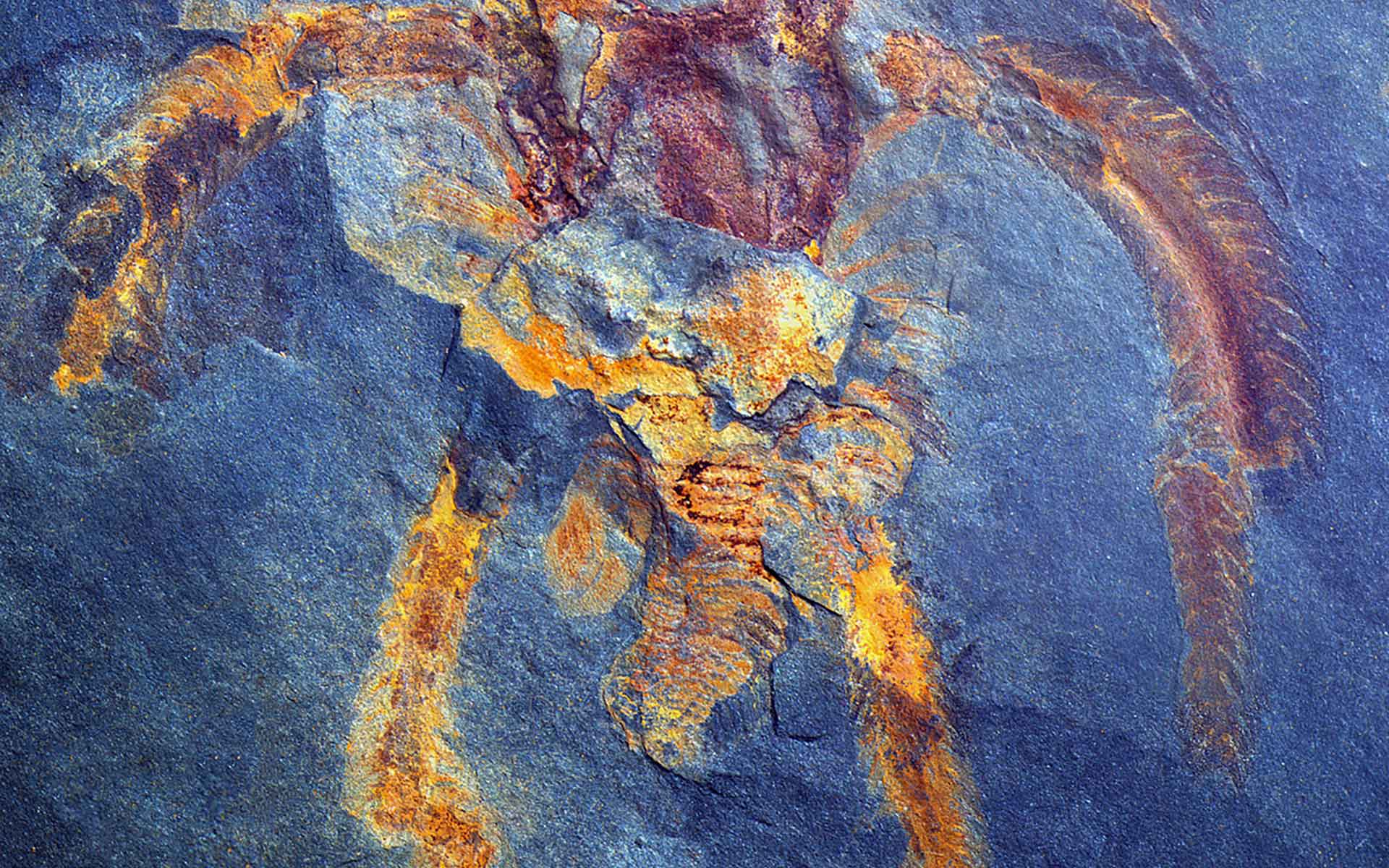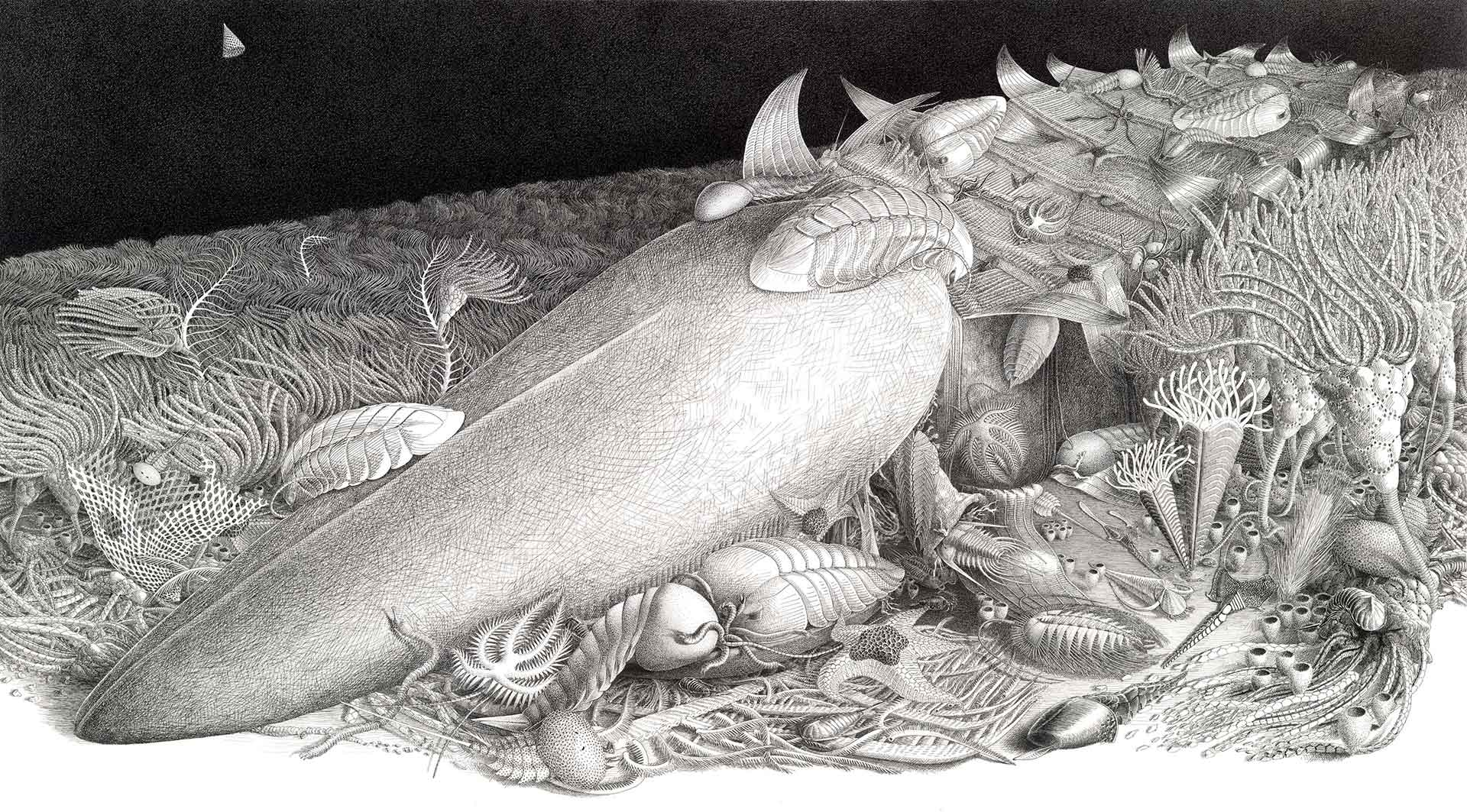
Soft-bodied Furca sp. marrellomorph fossil arthropod, one of the most iconic Burgess Shale-type fossils from the Fezouata Shale.
Geological Period
Ordovician (485.4 ± 1.9 to 443.8 ± 1.5 Ma)
Main geological interest
Paleontology
Location
Drâa-Tafilalet Region, Zagora Province, Ternata Plain, Morocco.
30°31’57.0″N, 5°49’58.0″W
Soft-bodied Furca sp. marrellomorph fossil arthropod, one of the most iconic Burgess Shale-type fossils from the Fezouata Shale.
Exceptional fossil preservation bridging the Cambrian Explosion and the Great Ordovician Biodiversification.
The biodiversity, abundance and quality of the fossils preserved at the Fezouata Shale, particularly the assemblage at Jbel Tizagzaouine, offer a unique window into one of the most important evolutionary transitions in the history of Life on Earth and the establishment of the ecologically-modern marine biosphere. The geology and paleontology of the Fezouata Shale has produced landmark contributions across multiple disciplines, including taphonomy, stratigraphy, and evolutionary biology, all made possible thanks to the long history of geological research on the Anti-Atlas region and sustained efforts to characterize the fossil richness of the Fezouata Biota over the last two decades (Destombes, 1962; Saleh et al., 2021).
- Geological description
The Fezouata Biota represents the only major Konservat-Lagerstätte that reflects an open marine Ordovician fauna, and critically documents the earliest stages of the Great Ordovician Biodiversification. It bridges a major gap in our understanding of marine ecosystems between the middle Cambrian and the Silurian (Van Roy et al., 2010; Van Roy et al., 2015b). Among the 185+ taxa identified, some belong to typical post-Cambrian groups (e.g. asterozoans, bivalves, cephalopods, crinoids), while others are icons of exceptionally preserved Cambrian Burgess Shale-type biotas (e.g. lobopodians, radiodonts, sachitids), providing pivotal insight into the origin and evolution of major animal clades (Destombes, 1962; Van Roy et al., 2015b). Furthermore, several Fezouata species (e.g. cheloniellids, phyllodocids, various chelicerates) represent the oldest occurrences of their groups. The sedimentology, stratigraphy, paleoenvironment and geological history of the Fezouata Shale have been characterized in detail, and analyses of Fezouata sediments have significantly refined our understanding of soft-tissue taphonomy (Saleh et al., 2021). Jbel Tigzazaouine represents one of the most complete and easily accessible sections through the main interval of exceptional preservation in the Fezouata Shale, and is the site of some of the most important discoveries. Its sedimentology is typical for the intermediate bathymetry at which the Fezouata Biota lived, and the hill offers an excellent vantage point, overlooking all major geological features of the area.
- Scientific research and tradition
Abundant and diverse shelly faunas have been described from this open marine locality since the 1950s (Destombes, 1962), but the first exceptionally preserved soft-bodied fossils were discovered in the early 2000s. Since then, studies on the biological diversity, depositional environment, geological age, and taphonomy have characterized this locality in detail (Van Roy et al., 2010; Saleh et al., 2021).
- Reference
Destombes, J. (1962) ‘Stratigraphie et paleogeographie de l’Ordovicien de l’Anti-Atlas (Maroc): un essai de synthese’, Bulletin de la Société Géologique de France, S7-IV(3), pp. 453–460. Available at:https://doi.org/10.2113/gssgfbull.S7-IV.3.453.
Saleh, F. et al. (2021) ‘Insights into soft-part preservation from the Early Ordovician Fezouata Biota’, Earth-Science Reviews, 213, p. 103464. Available at: https://doi.org/10.1016/j.earscirev.2020.103464.
Van Roy, P. et al. (2010) ‘Ordovician faunas of Burgess Shale type’, Nature, 465(7295), pp. 215–218. Available at: https://doi.org/10.1038/nature09038.
Van Roy, P., Briggs, D.E.G. and Gaines, R.R. (2015) ‘The Fezouata fossils of Morocco; an extraordinary record of marine life in the Early Ordovician’, Journal of the Geological Society, 172(5), pp. 541–549. Available at: https://doi.org/10.1144/jgs2015-017.
Van Roy, P., Daley, A.C. and Briggs, D.E.G. (2015) ‘Anomalocaridid trunk limb homology revealed by a giant filter-feeder with paired flaps’, Nature, 522(7554), pp. 77–80. Available at: https://doi.org/10.1038/nature14256.
- Author(s)
Khadija El Hariri
Université Cadi Ayyad, Marrakech, Maroc
Bertrand Lefebvre
Université Lyon 1, Villeurbanne, France
Peter Van Roy
Ghent University, Ghent, Belgium
Abderrahmane Soulaimani
Université Cadi Ayyad, Marrakech, Maroc
Ahmid Hafid
Université Cadi Ayyad, Marrakech, Maroc
Ali Bachnou
Université Cadi Ayyad, Marrakech, Maroc
Joseph P. Botting
Nanjing Institute of Geology and Palaeontology, Nanjing, China & National Museum of Wales, Cardiff, UK
Allison C. Daley
University of Lausanne, Lausanne, Switzerland
Juan Carlos Gutiérrez-Marco
Universidad Complutense de Madrid, Madrid, Spain
Farid Saleh
Yunnan University, Kumning, China


